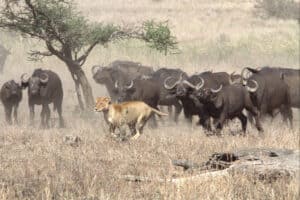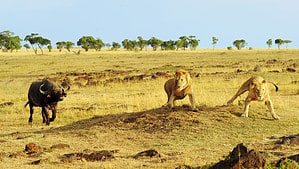Buffalo is a term that is applied to many mammals, sometimes incorrectly. After all, the bison of North America are only tangentially related to the buffalo despite belonging to the Bovidae family. As a result, it’s easy for people to confuse a cape buffalo for a water buffalo. We’re going to take a closer look at these two lumbering mammals and give you insights into their differences. Come learn to tell the differences between a cape buffalo vs water buffalo.
Comparing a Cape Buffalo and a Water Buffalo
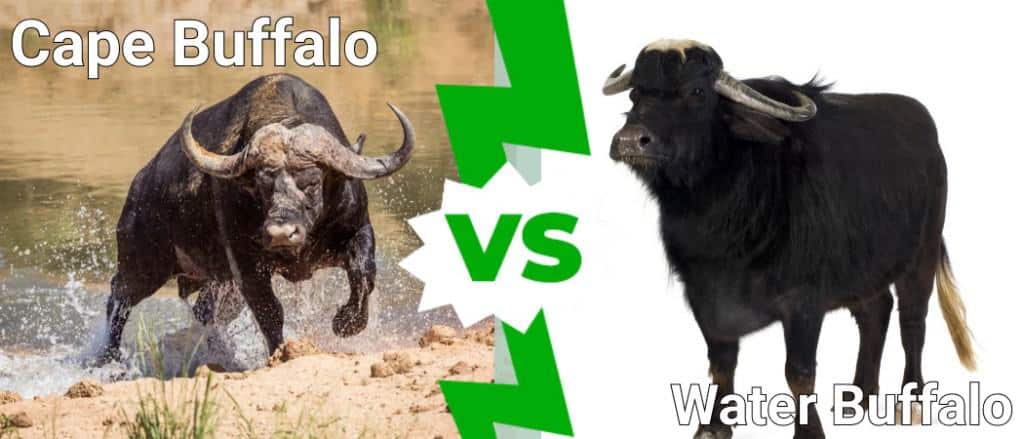
| Cape Buffalo | Water Buffalo | |
| Size | Weight: 1,323lbs-2,000lbs Height: 51in-67in Length: 67in-96in | Weight: 880lbs- 1,200 on average, but 2,600lbs at maximum Height: 48-56in Length: 80in-118in |
| Location | Southeastern Africa | Southeast Asia |
| Genus | – Syncerus caffer – One of three subspecies of African buffalo | – Bubalus bubalis |
| Horns | – Horns form a boss, a section where the two horns grow almost together – Horn curl much lower, past their eyes in many cases | – No boss – Horns curl outward and then upward, never dipping below their eye level |
| Domestication | Never domesticated | Heavily domesticated in Asia and used for plowing fields, milk, and meat |
The Key Differences Between Cape Buffalo vs Water Buffalo
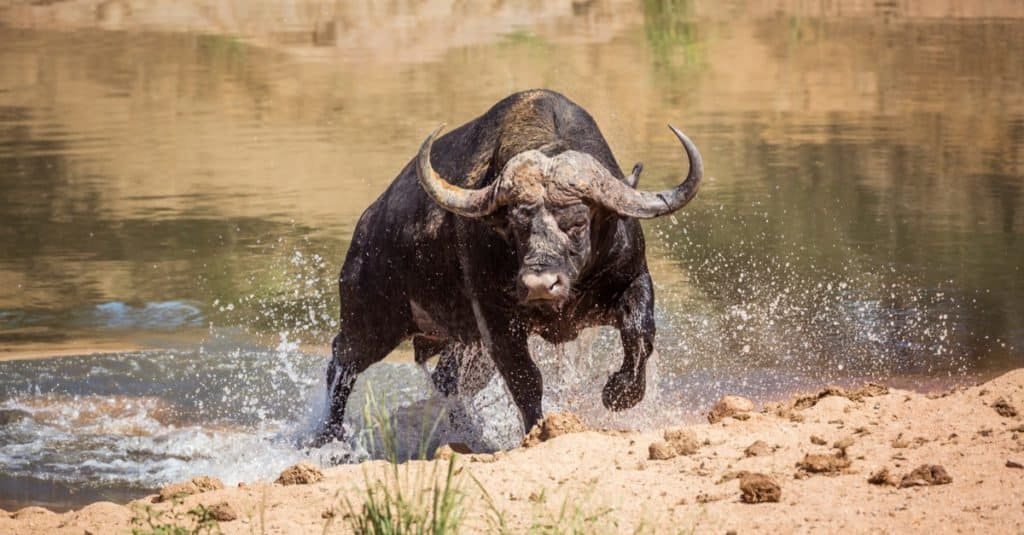
Cape buffalo can race up to 40 mph, jump up to 6 feet vertically, and can quickly pivot to combat predators.
©PACO COMO/Shutterstock.com
The most profound differences between a cape buffalo and a water buffalo include the area of the world they inhabit, their size, and their domestication. All of these factors can provide you with the information you need to determine which of the two bovines you’re looking at.
Cape buffalo live in Africa, and water buffalo live in Asia. Specifically, these creatures live in the southeastern portions of their respective continents. These animals do not share any overlapping habitats.
The cape buffalo weighs less than the water buffalo, but it is taller at the shoulder on average. Still, it’s shorter in terms of length. The cape buffalo has never been domesticated and all attempts at doing so have failed. This factor is something they share with wild bison in North America. However, water buffalo have been domesticated very well, and they are used to do work as well as to provide meat and milk.
All in all, these creatures may have similar looks in terms of their fur color and robust horns. Yet, these differences that we’ve mentioned here along with the others that we will go in-depth about later in the article will show you just how dissimilar they are.
Cape Buffalo vs Water Buffalo: Size
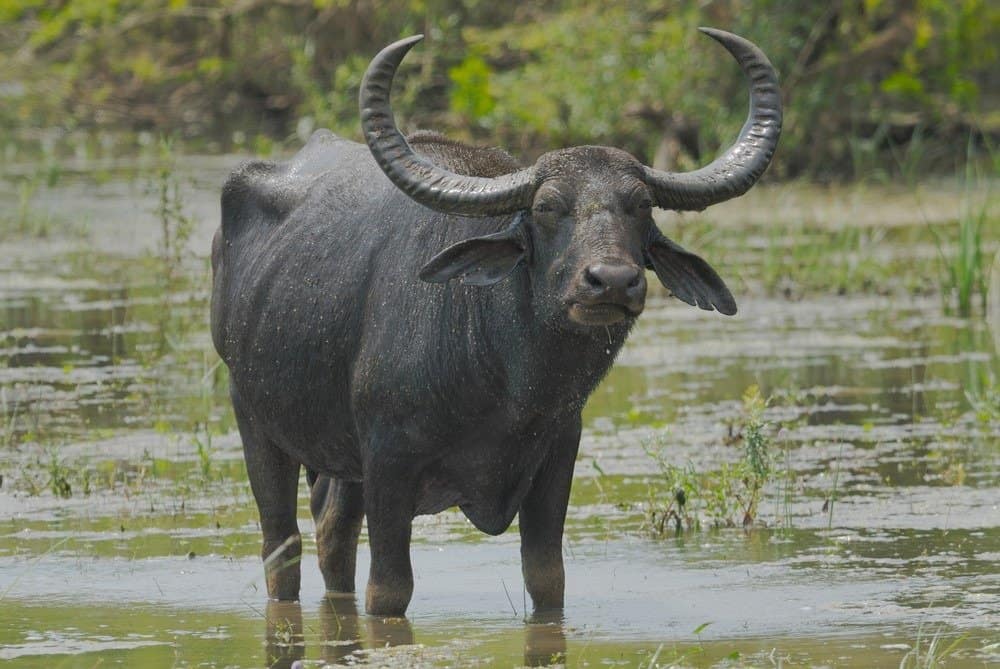
The largest water buffalo are bigger than cape buffalo.
©Hugh Lansdown/Shutterstock.com
The water buffalo is bigger than the cape buffalo. The sizes can be confusing when looking at the averages for each species. After all, the cape buffalo appears much larger at 2,000lbs, 59 inches in height, and 71 inches in length. The water buffalo’s average size is about 1,200lbs, 56 inches tall, and 108 inches long.
Yet, the larger versions of the water buffalo are quite common, and they are absolutely massive. They can reach sizes of 2,600lbs, closer to 120 inches long, and about 60 inches in height. The outliers on cape buffalo are not documented as well as the water buffalo owing to the latter’s domestication.
Thus, we are going to consider the water buffalo a larger animal overall.
Cape Buffalo vs Water Buffalo: Location
Cape buffalo only live in Africa, but water buffalo live in Asia. Also, cape buffalo is one of three subspecies of buffalo that roam that continent of Africa. These creatures are most common in the southeastern portion of the continent. You can find them in countries such as Kenya, Botswana, South Africa, and many other countries.
Water buffalo live in Southeast Asia. They’re common in countries such as India and China, and over 95% of all water buffalo are located in Asia. Thus, when someone says that there are small herds in other parts of the world, remember that those herds comprise a small portion of the total population.
Within these areas, both species are known for spending a lot of their time in or near water. They are vast animals that need water to drink and cool themselves, especially in the summer heat. Remember, neither of these species is located in North America.
Cape Buffalo vs Water Buffalo: Genus
Cape buffalo have the scientific name Syncerus caffer, and water buffalo bear the scientific name Bubalus bubalis. The two animals are both members of the Bovidae family, but they are not too closely related to one another.
Moreover, the cape buffalo is just one of three different species of African buffalo. The other two are the forest buffalo and Sudan, or West Africa buffalo. Each subspecies has unique traits that help differentiate them from each other.
Cape Buffalo vs Water Buffalo: Horns
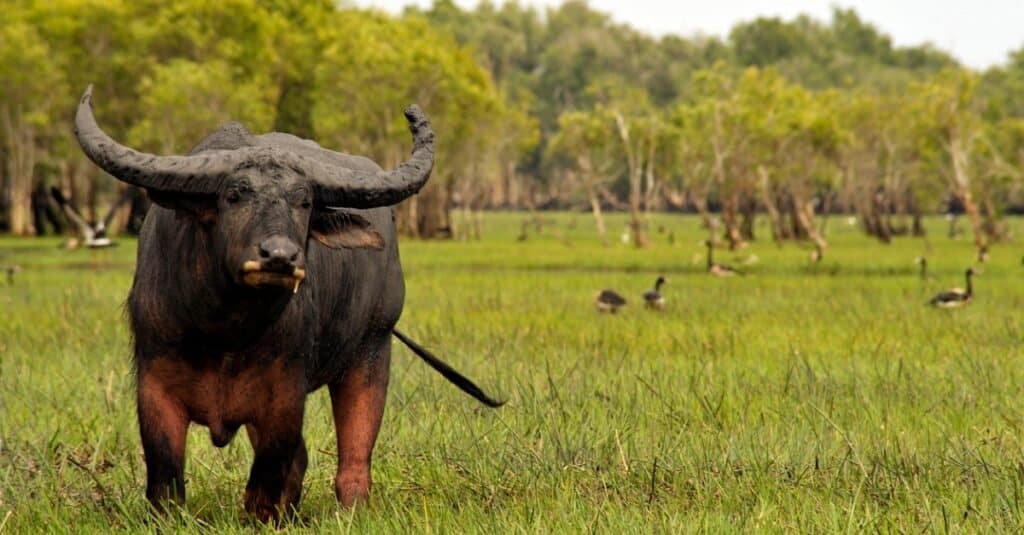
Water buffalo’s horns do not connect in the middle to form a boss
©iStock.com/SvdM
Cape buffalo have horns that start growing on the head very close together, forming a nearly solid plate on their forehead that is called a “boss.” The water buffalo does not have a boss; their horns grow separately and distinctly from one another.
The cape buffalo’s horns extend outward and then curl downward before rising above the head. Their horns curl lower than their eye level in most cases. Yet, water buffalo’s horns have a slight downward curl before growing upward, never dipping below the animal’s eye level.
You can look at these animals’ horns and tell the difference between them almost immediately.
Cape Buffalo vs Water Buffalo: Domestication

Water buffalo are often used to help in agriculture
©David Havel/Shutterstock.com
Cape buffalo are not domesticated and all attempts to domesticate them have failed. However, water buffalo are highly domesticated creatures that are used for agriculture of all sorts. They plow fields, carry loads, pull carts, provide milk, and are slaughtered for their meat.
Thus, if you see a buffalo working for humans, it’s probably a water buffalo since neither the African buffalo nor the American bison is domesticated.
Many differences exist between cape buffalo and water buffalo. Although they’re both large bovines with massive horns, you’re now equipped to tell them apart using sizes, horns, and their natural ranges. With this information, you can determine which creature you’re looking at in a matter of seconds, especially if you focus on their horns!
The photo featured at the top of this post is © THP Creative/Shutterstock.com
Thank you for reading! Have some feedback for us? Contact the AZ Animals editorial team.




